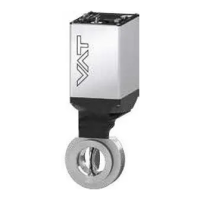What does «SR» mean on VAT 615 display?
- CCory MartinezAug 28, 2025
The «SR» (Service Request) on the display indicates that the valve unit is heavily contaminated, or the gate seal is sticking. Clean the valve unit and reset the control unit.

What does «SR» mean on VAT 615 display?
The «SR» (Service Request) on the display indicates that the valve unit is heavily contaminated, or the gate seal is sticking. Clean the valve unit and reset the control unit.
Why VAT 615 Control Unit pressure is not ‘0’ after ZERO?
If the pressure is not ‘0’ after ZERO, it may be due to sensor voltage shifting, the system not being pumped to base pressure, or the sensor offset voltage exceeding ±1.4V. Wait until the sensor stabilizes before performing ZERO. Open the valve and bring the chamber to base pressure before performing ZERO. If the issue persists, replace the pressure gauge.
What does error «E 21» on VAT Control Unit mean?
Error «E 21» indicates that the rotation angle of the valve plate is limited during power up. This could be due to a valve plate centric adjustment issue, a heavily contaminated valve unit, or a mechanically obstructed valve plate. Adjust the valve plate, clean the valve unit, resolve any obstruction, and reset the control unit.
What does error «E 22» on VAT Control Unit mean?
Error «E 22» indicates that the rotation angle of the valve plate is limited during operation. This could be due to a heavily contaminated valve unit or a mechanically obstructed valve plate. Clean the valve unit, resolve any obstruction, and reset the control unit.
Why is VAT Control Unit PRESSURE CONTROL not optimal?
The PRESSURE CONTROL might not be optimal because the setup wasn't completed fully, LEARN wasn't performed, ZERO wasn't performed before LEARN, LEARN was interrupted, gas flow was unstable during LEARN, tuning wasn't done, the sensor range isn't suited for the application, or there is noise on the sensor signal. To resolve this, complete the setup procedure, perform LEARN, perform ZERO before repeating LEARN, repeat LEARN with stable gas flow, tune the valve for the application, use a sensor with a suitable range, and ensure a shielded sensor cable is used.
What does error «E 20» on VAT Control Unit mean?
Error «E 20» indicates that the limit stop of the valve unit was not detected. This may be due to a clamp coupling screw not being fastened. Tighten the screw and reset or restart the valve.
What does error «E 40» on VAT Control Unit mean?
Error «E 40» indicates a motor driver failure has been detected. Replace the control and actuating unit.
How to fix no dots lighted on VAT 615 Control Unit display?
To fix no dots lighted on the display, connect the valve to the power supply and make sure that the power supply is working.
What to do if my VAT 615's PRESSURE CONTROL is not optimal?
To optimize PRESSURE CONTROL on your VAT Control Unit, ensure the setup procedure is complete and perform LEARN. If you haven't already, perform ZERO before repeating LEARN, and ensure stable gas flow during the LEARN process. Tune the valve for your specific application and verify that the sensor range is suitable (controlled pressure should be >3% and < 98% of sensor full scale). Also, use a shielded sensor cable to avoid noise on the sensor signal.
What does it mean when my VAT 615 display shows «E 21» (fatal error - rotation angle of valve plate limited during power up)?
If your VAT Control Unit displays «E 21», it indicates a fatal error where the rotation angle of the valve plate is limited during power up. This could be due to the valve plate not being centrally adjusted, heavy contamination of the valve unit, or a mechanical obstruction of the valve plate. To resolve this, adjust the valve plate, clean the valve unit, and resolve any obstructions.
| Brand | VAT |
|---|---|
| Model | 615 Series |
| Category | Control Unit |
| Language | English |
Detailed specifications for the control and actuating unit and valve unit, including electrical and mechanical parameters.
Guidelines for installing the valve into the vacuum system, emphasizing safety precautions.
Guidelines for sensor connection to ensure fast pressure response time.
Details on electrical connections, including ground strap and connector types.
Wiring diagram for power and sensor connections with the optional SPS module.
Details DeviceNet connector type, pinout, wire colors, and signal descriptions.
Step-by-step guide to configure the valve for operation.
How to configure node number, baudrate and DeviceNet parameters.
Options for configuring pressure control algorithms: Adaptive, Fixed, and Soft Pump.
Procedure for learning system characteristics for adaptive pressure control.
How to configure Fixed PI parameters for pressure control.
How to configure the soft pump algorithm for pressure ramps.
Overview of tuning procedures for optimizing pressure control performance.
Step-by-step tuning procedures for the adaptive algorithm.
How to adjust the gain factor to optimize stability and response time.
How to adjust sensor delay to improve stability.
How to adjust setpoint ramp time for better pressure response.
How to adjust valve plate actuating speed for optimal response.
Procedures for tuning the fixed algorithm parameters (P-Gain, I-Gain).
How to tune the soft pump algorithm for pressure ramps.
Step-by-step guide for replacing the plate o-ring.
Procedure for replacing shaft feedtrough seals and plate o-ring.
Procedure for retrofitting or replacing control and actuating unit boards.
